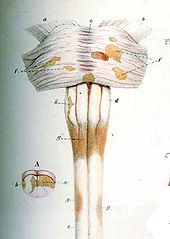Disclaimer: This page may contain affiliate links. We may earn a small commission for purchases made through links in this post, at no extra cost to you.
History of Multiple Sclerosis
The following pages describe the early medical history of multiple sclerosis. To read about historical cases of the disease, go here.
The history of MS goes back to the 1800's. Dr. Jean-Martin Charcot, a French neurologist, was the first person to see multiple sclerosis as a distinct and separate disease. He is sometimes known as “the father of neurology”. It was in 1868 when he named the disease sclerose en plaques. He summarized several previous reports of cases he believed were multiple sclerosis, and added his own findings as well.
He saw three signs and symptoms of MS, which aren't specific to the disease. They were very likely to be present in most people who had it, according to his observations.
Charcot's triad 1
- nystagmus
- intention tremor
- telegraphic speech
These were not the only symptoms he observed in those he found to have MS. He saw cognition changes which he called “marked enfeeblement of the memory” and “conceptions that formed slowly”. All in all, he was pretty accurate when it came to describing multiple sclerosis and his findings are taken to be fact.
Charcot tried many of the treatments of the day like strychnine (which is a deadly poison)- hmmm... In small doses it can stimulate the nerves. He even tried injections of gold and silver, the common treatment for the nerve disorder syphilis. He was surprised that none of the treatments really helped.
Although he was the first to name the disease he described, he was not the first to see it. A British professor of pathology, Robert Carswell (1793-1857) and Jean Cruveilhier (1791-1873), a French professor of pathologic anatomy, had both described and illustrated many of the clinical details of multiple sclerosis. But because they didn't recognize it as a separate disease and name it as such, they were not said to have discovered it.
In 1838, Carswell saw lesions in both the spinal cord and brain which he then illustrated in detail. Another pathologist – Georg Eduard Rindfleisch (1836-1908), this time from Sweden, saw that the lesions were found around blood vessels. This observation is probably where one of the newest discoveries in connection with CCSVI comes into play.
Other doctors were also seeing that MS was a specific disease. In 1873, Dr. Walter Moxen in England and Dr. Edward Seguin in 1878 in the United States. Other than it's many neurological symptoms, facts like women being more likely to develop MS, and that it is not directly inherited, not much else is known.
History of Multiple Sclerosis in the 20th Century
The 20th century brought about developments as far as what actually caused the disease. The discovery of bacteria in the 19th century and viruses in the early 20th century, led to research of viral causes of multiple sclerosis. In 1906, new chemicals were developed by Drs. Camillo Golgi and Santiago Ramon y Cajal, that helped scientists be able to see nerve cells better under a microscope.
History of Multiple Sclerosis 1920's
Dr. James Dawson used this technology to study the brains of his patients who had died with MS. He was very thorough in his descriptions of the inflammation around blood vessels as well as the damage to the myelin sheath of nerves. Other discoveries, like oligodendrocytes cells that make myelin, came shortly after in 1928 with the help of the microscope.
In 1925, came the first electrical recording of nerve transmission by Lord Edgar Douglas Adrian. Because of this study, scientists were able to learn how the nervous system actually works. It was also around this time that scientists began to think that toxins caused MS. This was because the damage to nerves occurred around blood vessels in the brain.
While this was going on, Dr. Thomas Rivers in New York City, produced and animal model of MS. He did this by injecting healthy lab animals with virus-free myelin. He then caused their immune system, not viruses, to attack their own myelin. This caused a disease similar to multiple sclerosis called “experimental allergic encephalomyelitis” (EAE).
This discovery in the history of multiple sclerosis eventually led to seeing MS as an autoimmune disease – the process by which the bodies on immune system attacks itself. I say eventually because more studies were still going on centering on the blood vessels in the brain. When the blood supply to the brain was blocked, the myelin would die. This resulted in what looked like the damage typical of multiple sclerosis.
There's more information on the History of Multiple Sclerosis. You can learn more by going on to Parts 2 and 3. There are also 2 pages which showcase some of the earliest instances of what we now believe to have been people with multiple sclerosis. Follow the links below to read more. Below that, you'll find a video about the history of the disease if that's more to your liking.
Here's an article from the National MS Society that you might find interesting as well.
| History of Multiple Sclerosis - Part 1 | Part 2 | Part 3 | History of Multiple Sclerosis - Cases Part 1 | Cases Part 2 |
Video of the History of MS
Dear Friends,
"Life in Spite of MS is a participant in the Amazon Services LLC Associates Program, an affiliate advertising program designed to provide a means for sites to earn advertising fees by advertising and linking to Amazon.com. We're also part of the Ebay Partner Network, another affiliate program."
We'd also like you to know it doesn't cost one cent more when you click through the links here on our blog. Not one single penny. And we will make a little extra cash when you do click through. We'll be ever so appreciative. You also have our word that we'll only link to things that we would use ourselves, (or wish we could have or use).
Sincerely,
Cir & Akrista
You are reading original content written by Akrista or Cir L'Bert of Life in Spite of MS. If you enjoyed reading this blog, please consider following us on Facebook, Twitter, Pinterest, and Instagram. See you there!
Privacy Policy ~ Advertising Policy ~ Disclaimer ~ Contact Us ~ About Us




New! Comments
Have your say about what you just read! Leave me a comment in the box below.